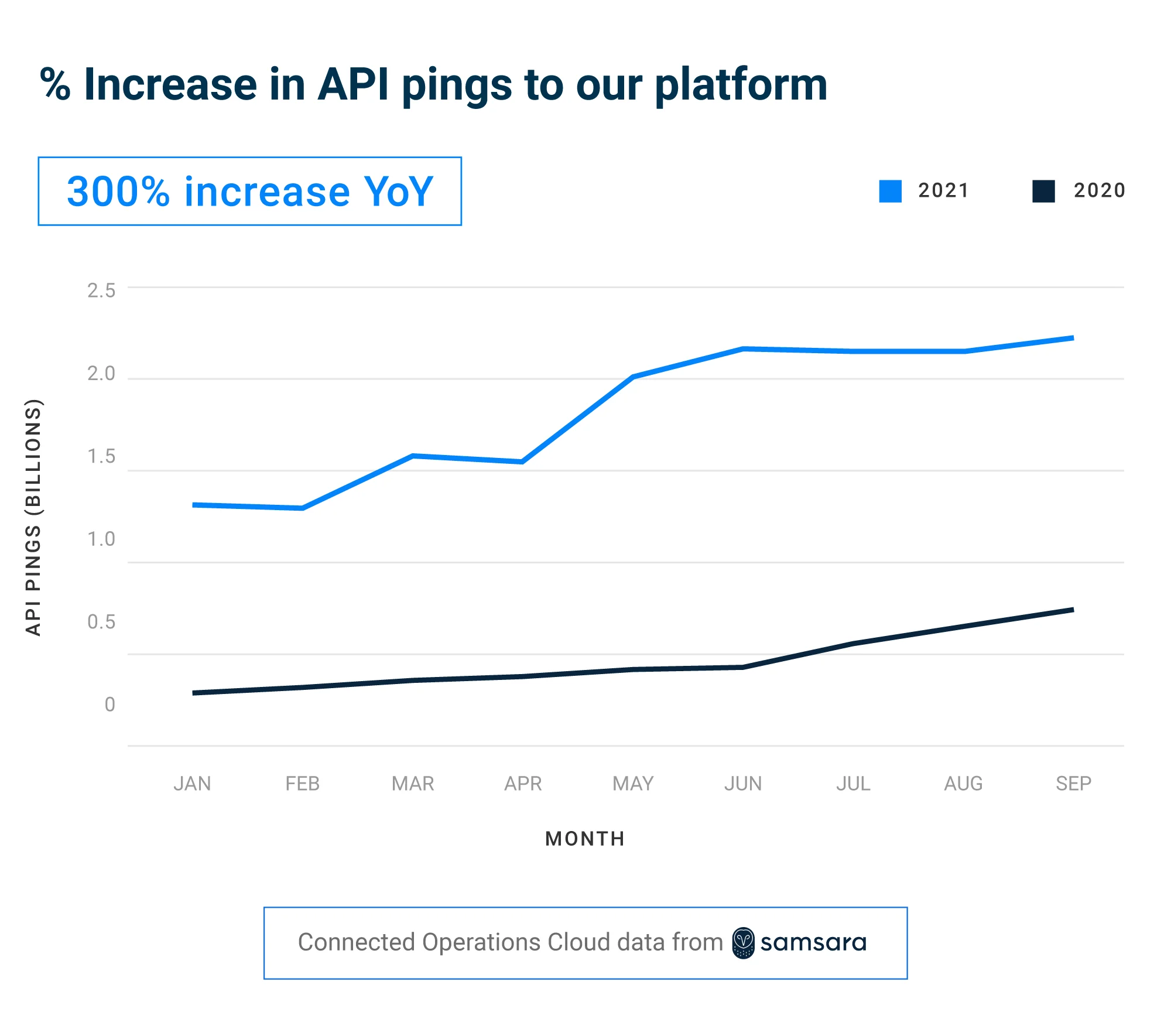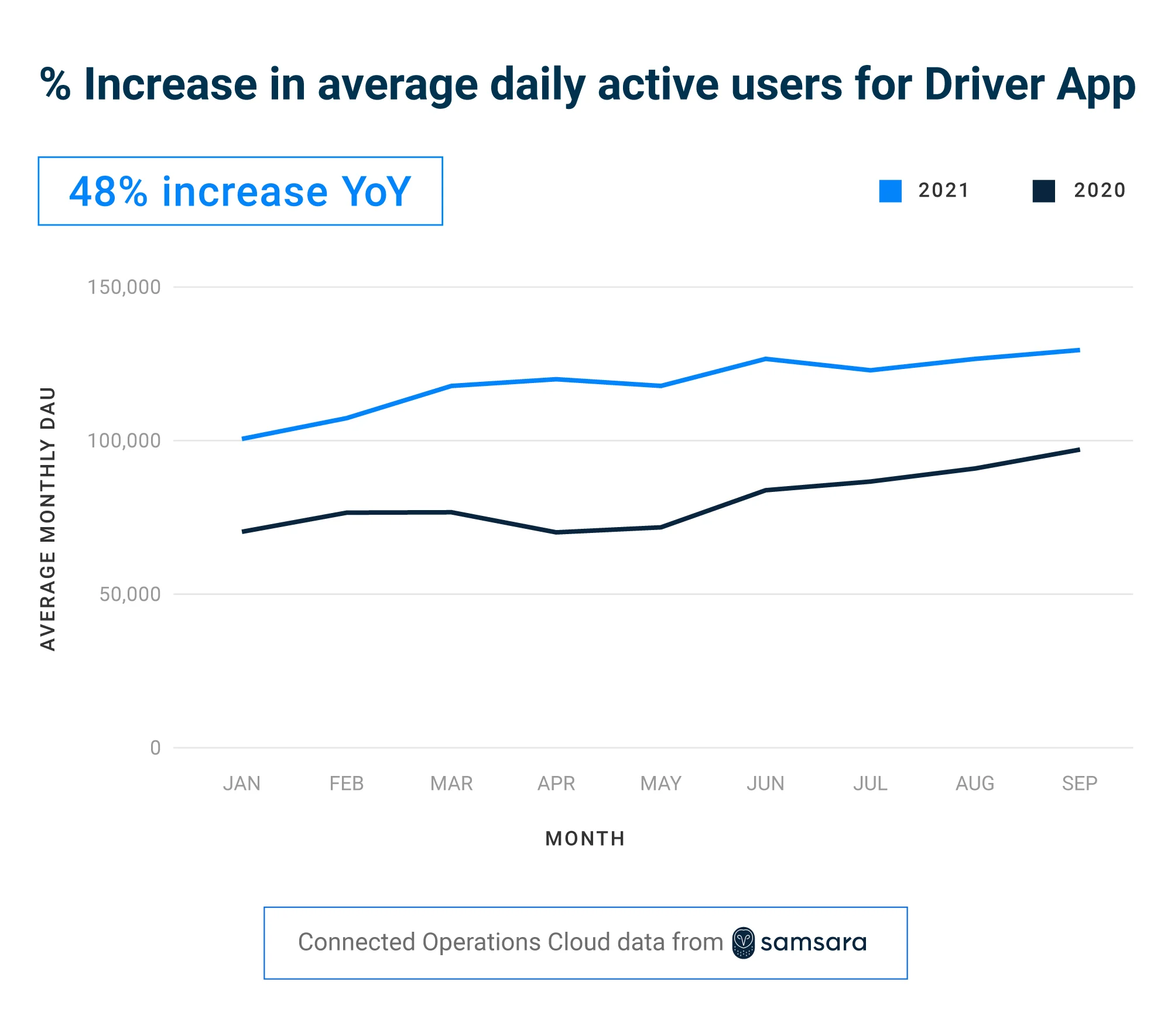Perspectives
Building a New Industrial Workforce: How AI and Digital Tools are Helping Combat the Labor Shortage
October 26, 2021

Get the latest from Samsara
Subscribe nowA new report from ManpowerGroup reveals that “U.S. employer thirst for hiring is at an all-time high”—especially among supply chain industries that have seen a surge in demand during the pandemic era, such as transportation, logistics, and warehousing. Meanwhile, labor shortages in these same industries are also at an all-time high. Companies have been offering both financial and non-financial incentives to attract and retain scarce talent throughout 2021. Now, they are facing the additional pressure of a fast-approaching holiday season, which experts anticipate will further increase demand and exacerbate these existing challenges.
At Samsara, we are seeing the effects of these pressures firsthand. On average, Samsara logged more than 12 million vehicle location data points per customer in the first nine months of 2021—a 46% year-over-year (YOY) increase—reflecting how fleets supporting physical operations are busier than ever. “The number one issue in our industry right now is staffing,” said Joel Davis, CFO at telecommunications company Satellites Unlimited. “It’s really difficult to hire people right now; there’s simply a lot of demand and not enough supply.”
In this increasingly demanding and competitive environment, how are industrial companies rethinking the way they work? Samsara data shows that our customers—spanning diverse industries such as transportation, utilities, manufacturing, and more—are increasingly leveraging digital tools and AI to help weather these challenges and improve the employee experience so they can both attract and retain employees. Using cohort analysis to control for growth in our customer count, we analyzed aggregated data from thousands of customers and found:
A 300% YOY increase* in application programming interface (API) pings to our Connected Operations Cloud. Our customers are using these API connections to
<a href="#section-1">break down data silos</a>and streamline internal processes and communication.A 48% YOY increase* in daily active users of our mobile Driver App, as well as a 100% YOY increase* (i.e. doubling) in usage of our digital Documents feature. Mobile workflows and digital documents are allowing industrial organizations to get new employees up to speed faster and modernize their day-to-day experience, helping to bridge the
<a href="#section-2">skills gap</a>.A 13% YOY increase* in AI detections per 1,000 miles driven from our vehicle dash cams, as well as a 129% increase so far this year* in AI detections from our site security cameras per customer. Our customers are increasingly able to leverage AI to proactively detect potential safety and security risks, automate previously time-consuming tasks, and
<a href="#section-3">improve the employee experience</a>.
Read on to dive deeper into our latest data insights and hear directly from our customers on how they’re responding to the pressures of today’s climate—plus how these technologies are shaping the new industrial workforce.
<div id="section-1">API connections are helping break down data silos and streamline internal processes, communication</div>
Today, companies are deploying a greater number of apps and systems across their business operations than ever before. Siloed systems can be a huge challenge to internal information-sharing and communication with employees in the field—a challenge exacerbated by increasingly remote work. In fact, surveys of employees in the field (such as commercial drivers) repeatedly show that communication is a key factor in retention.
APIs make it possible to share information between different systems and develop new information pathways that wouldn’t otherwise be possible. For example, using API endpoints between third-party or internal systems and the Samsara platform, many of our customers are able to connect the dots between previously disparate data sources. Many industrial organizations have identified APIs as their “largest enabler of digital transformation strategies,” especially when it comes to streamlining internal processes and communication.
At Samsara, we’ve seen this manifest in a 300% YOY increase* in API pings to our Connected Operations Cloud. A vast portion of these pings are going to and from Samsara and various transportation management systems (TMSs), helping companies streamline processes and communications related to compliance, routing, and dispatch.

For telecommunications utility company Uniti Fiber, API integrations have been critical in helping them break down data silos and communicate with technicians in the field more efficiently. Previously, their dispatch team had to synthesize data from multiple vendors in order to respond to an issue in the field. Then, they had to call around to find the right technician using a phone tree—which usually took 25+ minutes. Leveraging multiple API endpoints, they now see real-time fleet location data overlaid on a live view of their fiber network. This allows them to quickly identify the type of technician needed for a job, communicate with the proper personnel to handle the customer request based on proximity, and dispatch that person in minutes. “Being able to pull [real-time location data] on top of our network [via API] has been a huge game-changer for us,” said Uniti’s Manager of CAD & GIS Lindsay Hunt. “[It’s] helping us use our personnel resources more wisely.”
<div id="section-2">Mobile workflows and digital documents are helping get new employees up to speed faster, bridging the skills gap</div>
A 2021 research report of today’s frontline workers found that more than half (52%) said the opportunity to work in a more modern, digital environment would influence their decision to leave their current company. Today, industrial organizations must compete with high-tech companies by making their jobs more appealing and modern. Facing these pressures, many are embracing digital tools to modernize workflows and help newer employees make fewer errors when following a company process, bridging the skills gap.
At Samsara, we’ve seen a 48% YOY increase* in usage of our mobile Driver App, which has helped many of our customers streamline the driver experience via guided workflows and real-time updates. Similarly, usage of our digital Documents feature—which helps modernize the driver experience by reducing previously manual and time-consuming paperwork—has doubled comparing those same time periods* (100% YOY increase). In effect, these digital tools are allowing industrial organizations to get new employees up to speed faster and modernize their day-to-day experience.


For Gravity Oilfield Services, these digital tools are a key part of how they are keeping more than 300 field technicians across the nation engaged, safe, and productive. “There are a lot of tasks drivers have to follow each day. It can be challenging, especially when we have drivers who are working day and night 24/7,” said Agustín Chavarria, DOT Representative at Gravity. “With [app-based workflows], our drivers get easy-to-follow guidance to make sure they complete their start- and end-of-day tasks. Not only do these workflows help me save an hour of administrative work every day, but it gives me confidence that our drivers are safe and compliant when they’re on the road.” As a result of leveraging mobile workflows and digital documents, Gravity Oilfield has seen an 80% reduction in the number of HOS violations associated with uncertified logs, as well as a significant improvement in DVIR completion rates.
<div id="section-3">AI is helping proactively detect risks, automate previously time-consuming tasks, and improve the employee experience</div>
Beyond hiring and training, another key challenge posed by the labor shortage is employee retention. Across transportation, warehousing, and utilities, the U.S. Bureau of Labor Statistics reports a turnover rate of more than 46%, a high rate likely influenced by the challenging and sometimes dangerous nature of the work. As a result, many industrial organizations are turning to AI to help proactively detect both safety and security risks, automate previously manual tasks, and provide richer data to coach and reward employees—improving the employee experience.
For example, our dash cams use AI to detect and alert drivers to potential safety risks, such as distracted driving. Similarly, our site security cameras use AI to detect and alert managers to possible security risks, such as motion in restricted areas. Samsara data shows increased AI detections in both these areas. We’ve observed a 13% YOY increase* in AI detections from our dash cams per 1,000 miles driven, as well as a 129% increase so far this year* in AI detections from our site security cameras per customer.

O’Neal Steel, one of the largest family-owned wholesale metal distributors in the United States, is just one example of how industrial organizations are increasingly leveraging AI to improve the employee experience. With a handful of smaller sites that often go unstaffed during the late hours of the night, O’Neal Steel supervisors used to spend hours every morning passively searching through security camera footage to see if a delivery was made the previous night. Now, with AI-powered motion detection alerts, their team has experienced a 92% reduction in time spent manually reviewing footage. Not only is this intelligent automation saving the company 100 hours per week—but it has also made a huge impact on their employees’ day-to-day experience, helping them retain talent in a competitive market. “It saves so much time and frustration,” said CTO Sateesh Donti.
Leaders shaping the new industrial workforce
In response to the pressures of today’s climate, including skyrocketing demand and historic labor shortages, industrial organizations are rethinking the way they work. In this climate, organizations are having to find unique ways to both grow their employee base and increase productivity—and technology is helping solve both sides of that coin. Leaders in this space are seeing step-changes in the employee experience, leading the way for a new, more digitized industrial workforce.
Explore more data insights from Samsara
Samsara’s Connected Operations Platform collects more than 2 trillion sensor data points annually from IoT devices across diverse industries around the world. By organizing and analyzing these large volumes of data at scale—while taking the necessary measures to ensure complete customer privacy—Samsara's data science team reveals insights that customers can apply to their own organizations.
<div class="text-center"><a id="blog-inline-1" href="/blog/category/data-insights/" title="See more on our blog" class="btn btn--blue">See more on our blog</a></div>
Methodology
For more information about your rights and how we may process your personal data, please see our privacy policy. Methodology notes:
For each of the charts/metrics produced for this article, we looked at cohorts of customers who joined Samsara prior to the time period examined in order to control for the effects related to our growing customer base.
The customer cohorts varied in size but sample sizes were large enough to produce statistically significant trends and ensure complete anonymity of the customer sample.
*YOY increases in API pings, daily active users of our Driver App, and usage of our digital Documents feature were calculated by comparing January through September of 2021 (the most recent month for which we have data) to the same time period in the previous year. The YOY increase in dash cam AI detections was calculated comparing the past three months, July through September of 2021, to the same time period in the previous year. The increase in AI detections from site security cameras was calculated from the beginning of this year, January 2021, through the latest month for which we have data, September 2021.
Get the latest from Samsara
Subscribe now














